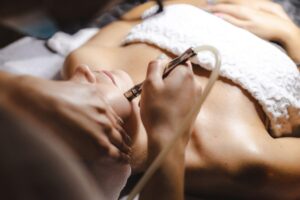Polycystic ovary syndrome is often associated with abnormal levels of androgens in the body that interferes with your body weight, hair growth, menstrual cycle, and even ovulation. It affects about 8-13% of women in their reproductive age and 70% of them remain undiagnosed.
The abnormal body changes can cause diabetes, cardiovascular diseases, cholesterol problems, and even endometrial cancer. So, it is important to get a health check-up when you notice any symptoms. The most common symptom is chin hair growth and it will be the main focus of our article.
Table of Contents:
- Part 1: What is PCOS Chin Hair?
- Part 2: Is Chin Hair a Sign of PCOS?
- Part 3: Why Am I Getting Chin Hair No PCOS?
- Part 4: How To Get Rid of PCOS Chin Hair?
- Part 5: Lifestyle Changes to Address PCOS Symptoms
Part 1: What is PCOS Chin Hair?
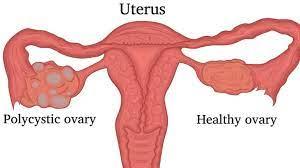
PCOS is a condition with multiple fluids-filled cysts around a women’s ovary that causes hormonal imbalance mainly excessive production of androgens. The androgens are responsible for the development of male characteristics like excess facial hair. This means overproduction of androgens in females can also cause excessive hair growth, particularly on the chin and other facial areas.
Moreover, the exact cause of PCOS is unknown yet but insulin resistance has been observed in most patients with hirsutism or PCOS. It promotes the synthesis of androgens which leads to male-like characteristics.
The unusual weight, excess chin hair, and acne make women conscious of their appearance which leads to overthinking and then eventually anxiety and depression.
Part 2: Is Chin Hair a Sign of PCOS?
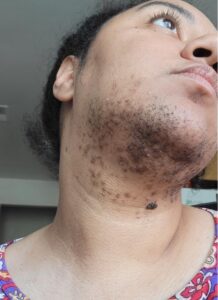
Excess chin hair is associated with hirsutism, a condition with abnormal hair growth on the face and body. It is due to the overproduction of androgens and is often associated with PCOS but not always. It can also be due to any adrenal gland tumor, medications, Cushing’s syndrome, or acromegaly as they can also interfere with your hormonal level.
Part 3: Why Am I Getting Chin Hair No PCOS?
Following are some reasons that you might have chin hair even with no PCOS:
- Syndromes such as Cushing’s syndrome that interfere with the level of androgens can lead to excess chin hair
- Getting chin hair at a certain time of your life might be in your genetics
- Medications like cyclosporins and minoxidil can cause excess hair growth
- Aging can be one of the causes as menopause also triggers the growth of excess hair on your chin, neck, and other facial areas
Part 4: How To Get Rid of PCOS Chin Hair?
You can get rid of PCOS hair on the chin but before that, it is important to confirm the diagnosis.
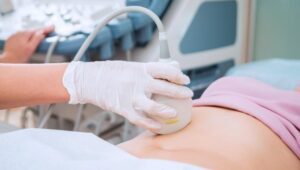
How can you diagnose PCOS?
- Women with PCOS usually have high levels of free and total testosterone
- If you are experiencing menstrual cycles that are more than 35 days apart, it is an indicator of ovarian dysfunction
- Blood tests can further determine the levels of hormones in your body
- Ultrasound can help in the diagnosis of any cysts in ovaries
Moreover, medical guidelines also suggest that if you have ovarian dysfunction, high levels of androgens, and polycystic ovaries then you most likely have PCOS. If you leave PCOS untreated, it can lead to type 2 diabetes, hypertension, and even uterine cancer. Therefore, timely management and regular health checkups are the most suitable options for getting rid of chin hair and controlling PCOS.
Hair Removal Methods For Managing Chin Hair
While undergoing treatment for PCOS, you can try the following ways for getting rid of unwanted chin hair.
Shaving
Shaving is a nearly painless method of removing your chin hair but it does not last long so you will have to do it often. There are no specific guidelines for PCOS so you can just shave the way you used to without any worries.
It is quick and convenient but if you have sensitive skin, you are also prone to cuts, nicks, and ingrown hair.
Tweezing
Tweezing pulls your hair from the roots and does not involve the use of any chemicals so it is also safe for those with PCOS. But, if you have sensitive skin, it can be quite painful. Moreover, tweezing can disturb your hair follicles causing infection and irritation.
Waxing
Waxing is a reliable option to get rid of your chin hair for at least 6 weeks. As those with PCOS have oily skin, so cleanse and exfoliate your skin properly before waxing. Also, PCOS skin is usually more sensitive so make sure that you are using a wax that is gentler and grabs more hair at a time.
Waxing without proper care can cause skin irritation, skin lifting, ingrown hair, and pain.
Depilatory Creams
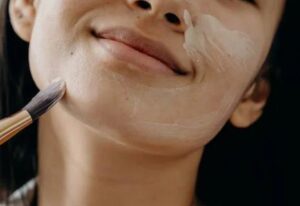
Another affordable long-lasting option for removing chin hair is the use of depilatory creams. The thioglycolic acid in these creams dissolves your hair without irritating the hair follicles. But, make sure that you are buying creams with more natural ingredients or soothing agents as sensitive skin require more care.
The use of harsh creams can cause skin burns, folliculitis, and allergic reactions.
IPL
IPL hair removal is a convenient, nearly painless, and safe method of hair removal as it is FDA-cleared. You just need to make sure that you have the right skin tone and hair color.
Moreover, those with PCOS can start using a device from low-intensity levels and then move to higher levels. Otherwise, it can cause redness, itching, and even burns the skin.
Laser Hair Removal
Laser hair removal also works for PCOS. It can provide you with 90% hair reduction. As the chin hair caused by hirsutism is thicker and darker, so an average of 8 sessions are required for most people using Alexandrite laser. Moreover, as your skin becomes sensitive to PCOS, so avoid sun exposure and use harsh chemicals after treatment.
The laser can cause skin redness and irritation but they subside after a short time.
Electrolysis
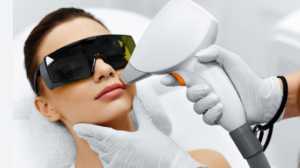
Electrolysis is a long-lasting and FDA-cleared solution for getting rid of your chin hair. It can take an average of 1-2 years for completing all your sessions. The type of needle used, current intensity, and technique caries with sensitive skin, so make sure you tell the electrologist about your skin and health condition.
It is usually painful and can cause redness, scarring, and hyperpigmentation in some cases.
Part 5: Lifestyle Changes to Address PCOS Symptoms
Healthy Diet and Regular Exercise
A combination of a healthy diet with regular exercise can help in decreasing insulin resistance which further minimizes the excess androgen levels in the body. Experts suggest an exercise of 3 hours a week. You can start with light exercises and then move to vigorous exercise eventually.
Diet and Weight Management
Keeping your diet and weight in check can also help with decreasing depression, and hyperandrogenism, and managing your menstrual cycles. A healthy diet for PCOS includes a high-fiber and low-sugar diet and avoiding processed food. You can reduce weight by eating in smaller portions and exercising regularly.
Reduce Stress and Sleep Adequately

Reduction in your stress and adequate sleep can help regulate the levels of insulin and reduce inflammation which further leads to the management of PCOS. Yoga, walking, and other mind-relaxing activities can help in stress reduction, and herbal tea can help you relax and sleep peacefully.
Medical Interventions for PCOS-related Hormonal Imbalance
Doctors can also prescribe some medications for controlling the hormonal imbalance and induce ovulation. These medications include letrozole, clomiphene, metmorphin, and gonadotropins.
Surgeries are also done in some cases to remove the tissues that produce androgens.
Conclusion
PCOS is caused by excess levels of androgens in the body which causes abnormal facial hair growth, especially the chin hair. It not only affects physical health but also causes anxiety and depression. Therefore, even if PCOS cannot be cured, you still need to manage both your physical and mental conditions to make sure it affects you minimally.
For the best management plan, it is important to contact professionals and take guidance from them. Additionally, make sure that you are sticking to this since no one but only you can solve the problem with adequate self-care and treatment.

 By myulikeadmin
By myulikeadmin
